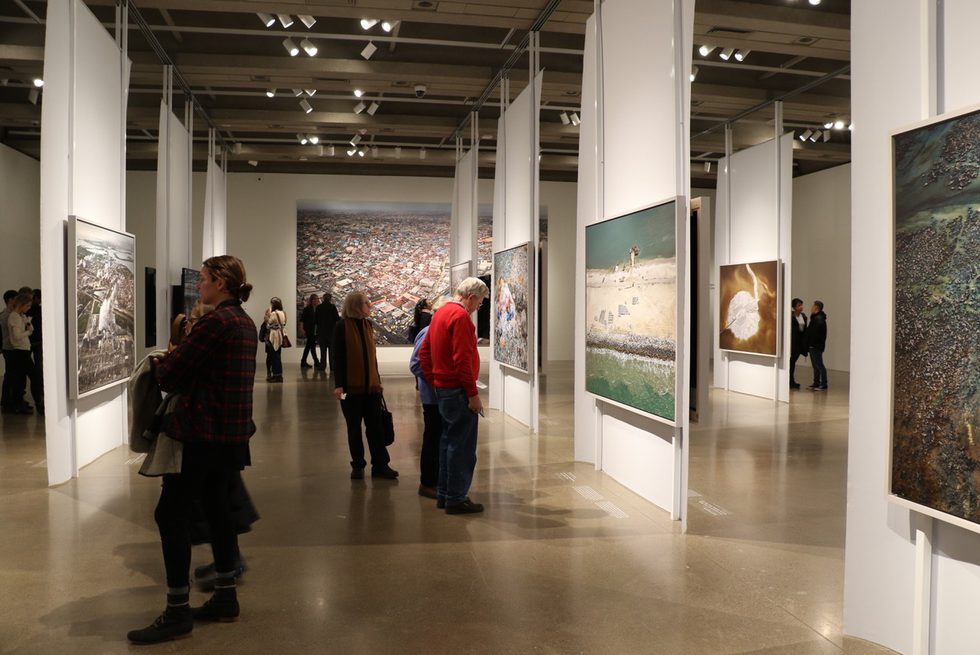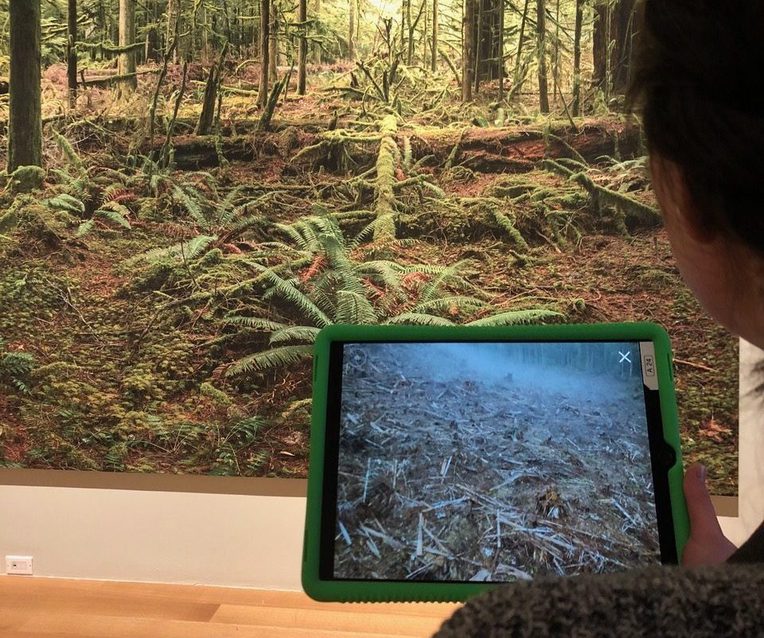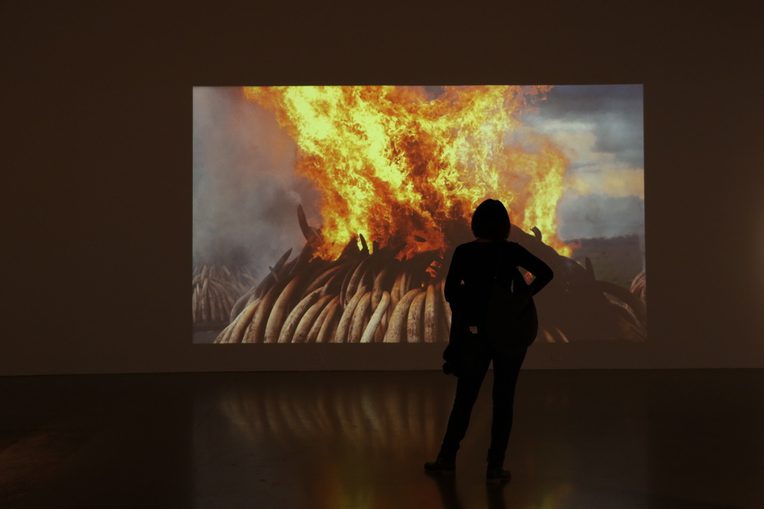
Our entrance into Anthropocene was initiated by a loud noise of what we imagined to be a bomb exploding. Repeated on a loop from a concealed source, this sonic manifestation of violence ushered us into the exhibit’s scenes of industrial imagery—mining, agriculture, forestry, quarries, irrigation systems, landfills, and urban sprawl. Anthropocene is an interactive multimedia experience, created by photographer Edward Burtynsky and filmmakers Jennifer Baichwal and Nicholas de Pencier. Premiering at the Art Gallery of Ontario (AGO) in September 2018, this exhibit brought together photographic works, murals, short films, and augmented reality (AR) sculpture installations. Accompanied by a feature-length documentary film, an art book, and educational programming, the exhibit forms just one part of the artists’ larger Anthropocene project. The AGO exhibit invited visitors to “come see the art you helped create” by bearing witness to humanity’s destructive impact on the planet. Scenes of large-scale resource extraction, population density, and terraforming, accompanied by apocalyptic messages, worked to inspire reflection of our relations with and impacts upon the world. The exhibit asked visitors: “What does a good Anthropocene look like to you? How can we change the way we affect the Earth?”—followed by a reminder to tag Instagram pictures with #myAnthropocene.
The exhibit was organized into four rooms, all marked by a minimalist design and tone. With few directives, the structure of the space inspired self-direction and reflection throughout, encouraging visitors to confront their role as complicit participants in the Anthropocene. By presenting their work as “evidence” of the Anthropocene, the exhibit drew on the conventions of a scientific research presentation—reflecting an aesthetic modality, that Jacques Rancière (2009) identifies as particular and political in its ordering of sense and sense-making. Presented in this way, Anthropocene also demonstrated the powerful role of photography and film imagery in shaping collective perceptions and understandings through such (Western scientific) ways of knowing.
In the first room of the exhibit, captivating aerial photographs and video installations were organized in a gridlike fashion. Mounted on lightweight material resembling white sheets under dim overhead lighting, the scenes of industrial landscapes, urban cityscapes, landfills, and parking lots at first appeared abstract and surreal.
The surreal quality of the images, the juxtaposition of terror and pleasure, reverberated in the experience of the exhibit.
The imagery was captivating as its painterly qualities, tactile composition, and sharp, deep focus drew out detailed textures while depicting global industrial activity and its consequences. The juxtaposition of terror and beauty in the photography, also present in Burtynsky’s earlier works, foregrounded an ironic relationship between aversion and attraction to destruction. Kenneth Little (1991) suggests that such imagery, or “ruin porn,” highlights a tendency for voyeurism and an erotic pleasure taken in the act of looking at objectified nature—usually presented and captured”in pictures. The surreal quality of the images, the juxtaposition of terror and pleasure, reverberated in the experience of the exhibit. Immersing and implicating viewers in the work, the exhibit aroused discomfort around what Walter Benjamin (1968, 234) identified as an “intimate fusion of visual and emotional enjoyment.”

Wood floors, an enclosed ceiling, and soft lighting brought a warm tone to the smaller second room. In this intimate space we were brought deep into the lush, vibrant greenery of old-growth forests in British Columbia. It was here that we learned the source of the initial sonic explosion—a looping film of exploding trees. The accompanying text explained that explosives are used to help so-called danger trees decompose quickly, contributing to what the artists term a “good Anthropocene” through the (human) management of old growth. In this framework, a good Anthropocene is a nature effectively controlled by humans through technological means. Colonial ecological beliefs and human determinism dominate such Anthropocene logics; natural environments are framed as simultaneously endangered by human activity and in need of human intervention. Alternatively, the anthropologist Natasha Myers has critiqued colonial ecological efforts to control nature and instead advocates for conspiring with plants for more livable futures. Myers’s vision of a Planthropocene, like Donna Haraway’s (2016) Chthulucene, works against the colonial logics of the Anthropocene by refusing nature/culture binaries and decentering anthropos in the stories we tell. Similarly, Heather Davis and Zoe Todd (2017, 775) write: “Rather than positioning the salvations of Man—the liberations of humanity from the horrors of the Anthropocene—in the technics and technologies of the noosphere, we call here for a tending once again to relations, to kin, to life, longing and care.” By rejecting human exceptionalism in favor of collaboration and relationality, these scholars remind us that our existence is an entangled one and that human efforts to isolate and dominate nature are part of the problem.

Yet a nature/culture binary became more pronounced by the third room of the exhibit. Here, a film installation depicting the actual and symbolic burning of ivory tusks confiscated from poachers in Kenya took center stage. Two AR installations complemented the film—one presented Sudan the rhino, the last male of the extinct northern white rhinoceros, while the other indexed the pile of ivory tusks seen in the film before the burning commenced. On the other side of the room, two mural-sized images of coral reefs illustrated an ocean world under threat of bleaching. This third space focused on the commoditization of nature, in the form of specific nonhuman forms of life—depicting a process of what Anna Tsing (2015, 63) calls “salvage accumulation.” The tone of this room urged toward preservation and conservation of endangered and vulnerable nature. Encouraging us to take responsibility and help “save” reefs and rhinos, this portion of the exhibit was marked by a man-the-savior or -ruler narrative that is common in Western epistemologies.
Walking into the final room of the exhibit felt like entering a computer. The area was enclosed by blue walls covered in graphs and statistics. These numbers and measurements accompanied interactive digital diagrams and displays that relayed information about global consumption practices and consumer options. The technosolutions proposed included: choosing greener building materials; using reef-friendly sunscreens and snorkeling responsibly; reducing petroleum consumption; recycling old marble countertops while ensuring that any new marble countertops or tile is made with renewable resources; recycling lithium batteries; buying local, organic, and sustainable food products; and supporting NGO efforts (the list included organizations like the Ancient Forest Alliance, the Stop Community Food Centre, Canada’s Swim Drink Fish, the Stop Ivory and Elephant Protection Initiative, the Pure Earth Institute, and Human Rights Watch).
The somber tone of concern surrounding the Anthropocene that prevailed throughout most of the exhibit was replaced here by a hopeful narrative of climate change mitigation. Yet the call for individuals of means in the global North to make the choice to simply consume better provided a neoliberal solution that refuses to confront the problems of (neo)colonial capitalism. As Thomas King (2013) reminds us, the colonial-capitalist desire for profit thwarts the possibility of an ethical approach to land. The exhibit thus followed a story of late capitalist human dominion of the Earth, which was reiterated in attempts to find better, more sustainable ways of being without relinquishing any entitlements and privileges or rethinking our relations with the land, animals, nonhuman existents, and each other.
The exhibit concluded with a digital questionnaire that asked: “In a word, how does what you’ve seen here today make you feel? Informed, sad, suspicious, worried, unconcerned, motivated, or angry?” But what do these feelings really mobilize? The Anthropocene exhibit and its anticipated responses constituted the Anthropocene as what Bruno Latour (2004) has called a matter of fact—a partial and inescapably political rendering of matters of concern. By rejecting the Anthropocene as a matter of fact and turning to concepts like the Planthropocene and Chthulucene as matters of concern, we can move away from the impetus to support or debunk and, following Haraway, Myers, Davis and Todd, and King, shift to an ethics of relationality and care.
References
Benjamin, Walter. 1968. “The Work of Art in the Age of Mechanical Reproduction.” In Illuminations, edited by Hannah Arendt and translated by Harry Zohn, 217–51. New York: Schocken. Originally published in 1935.
Davis, Heather, and Zoe Todd. 2017. “On the Importance of a Date, or Decolonizing the Anthropocene.” ACME 16, no. 4: 761–80.
Haraway, Donna J. 2016. Staying with the Trouble: Making Kin in the Chthulucene. Durham, N.C.: Duke University Press.
King, Thomas. 2013. The Inconvenient Indian: A Curious Account of Native People in North America. Minneapolis: University of Minnesota Press. Originally published in 2012.
Latour, Bruno. 2004. “Why Has Critique Run Out of Steam? From Matters of Fact to Matters of Concern.” Critical Inquiry 30, no. 2: 225–48.
Little, Kenneth. 1991. “On Safari: The Visual Politics of a Tourist Representation.” In The Varieties of Sensory Experience: A Sourcebook in the Anthropology of the Senses, edited by David Howes, 148–63. Toronto: University of Toronto Press.
Rancière, Jacques. 2009. "The Aesthetic Dimension: Aesthetics, Politics, Knowledge.” Critical Inquiry 36, no. 1: 1–19.